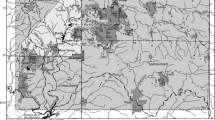Abstract
Here we investigate geochemical characteristics of sediment in different compartments of a karst aquifer and demonstrate that mobile sediments in a karst aquifer can exhibit a wide range of properties affecting their contaminant transport potential. Sediment samples were collected from surface streams, sinkholes, caves, wells, and springs of a karst aquifer (the Barton Springs portion of the Edwards (Balcones Fault Zone) Aquifer, Central Texas) and their mineralogy, grain-size distribution, organic carbon content, and specific surface area analyzed. Statistical analysis of the sediments separated the sampling sites into three distinct groups: (1) streambeds, sinkholes, and small springs; (2) wells; and (3) caves. Sediments from the primary discharge spring were a mix of these three groups. High organic carbon content and high specific surface area gives some sediments an increased potential to transport contaminants; the volume of these sediments is likely to increase with continued urbanization of the watershed.
Similar content being viewed by others
Author information
Authors and Affiliations
Additional information
Received: 13 April 1998 · Accepted: 6 October 1998
Rights and permissions
About this article
Cite this article
Mahler, B., Lynch, L. & Bennett, P. Mobile sediment in an urbanizing karst aquifer: implications for contaminant transport. Environmental Geology 39, 25–38 (1999). https://doi.org/10.1007/s002540050434
Issue Date:
DOI: https://doi.org/10.1007/s002540050434




